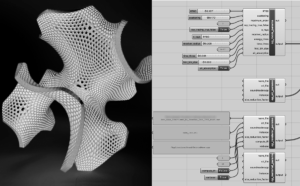
spatial computing tools for rhino grasshopper _ for instance, this room simulation using hybrid ray casting and image source modeling _ olivier pasquet _2020
I have been using rhino and grasshopper for quite a while. The first finished piece was kaspar in 2010. Room acoustics, ray casting, and other computational simulation tools were lacking for physical model synthesis. I am in need of apprehensive particular, fluid, and specular techniques in my work. The latter indeed are linking forms, and structures with sound and composition. This has been shown primarily for my personal esthetic approach.
There is indeed a tension between discrete and continuous computing models. Computing devices are generally discrete, but it is often useful to map them according to the continuous environment in which they are embedded. Aggregated programming models for space computers attempt to resolve this tension in different ways.
I personally see two simple models: the continuous universality of space-time and discrete-field computing.
The primary obvious application of these models is room acoustics, artistically linking architectural design with music composition. The second consists of applying those processes with nonrealistic physical characteristics and thus generating space-related sound synthesis. On a bigger scale, the final application links symbolic topological representations together into an object I eventually decide to identify as a composition piece or a base for narrative fiction.
Here will relatively soon be a grasshopper library for that. It is being developed at zhdk‘s icst in zurich, switzerland.
Other useful components for grasshopper:
| divisorplot | on3dpoints from divisors |
| numberspiral | on3dpoints from both cartesian and polar number spiral |
| primegenerator | generate prime numbers |